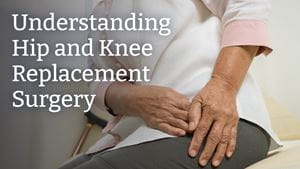
Each year, more than 450,000 total hip replacement surgeries and more than 800,000 total knee replacement surgeries are performed in the United States. With each surgery, it is important to understand the procedure and establish realistic goals for your post-surgery recovery.
Jason Lipof, MD, an orthopaedic surgeon with Rochester Regional Health, and the Medical Director of the Orthopaedic Center of Excellence for Hip and Knee Replacement at Rochester General Hospital, explains what makes a person a candidate for these surgeries and what the next steps might look like.
Schedule A Joint Replacement Consultation
Experiencing joint pain doesn’t automatically mean that you need a joint replacement.
Arthroplasty, or joint replacement surgery, is generally a last measure to treat pain that interferes with daily life and activities, and has not responded to appropriate non-surgical treatments such as exercise, weight loss, physical therapy, and medications.
Total hip replacement surgery is generally performed for late-stage conditions - most commonly osteoarthritis - or irreversible damage caused by fractures, worn cartilage, avascular necrosis, or after previous failed surgeries around the hip.
Similarly, partial, or total knee replacement surgery is most often performed for patients with osteoarthritis, rheumatoid arthritis, or for patients who have had prior knee scopes, meniscal tearing, or prior traumatic injuries. The type of replacement depends on many factors, including age, activity level and extent of arthritis.
Once you have exhausted non-operative treatments and are unable to do the activities that you need or want to do, it may be time to see a surgeon to discuss joint replacement.
There are several commonly-used approaches for hip replacement surgery. The anterior approach allows for a potentially quicker recovery with less pain, as it does not require cutting muscle or tendons to perform the replacement, and there are fewer limitations after surgery and a lower dislocation rate. Posterior approach hip replacement is more traditional, and potentially better for patients with prior hip surgeries or deformities around the hip
Knee replacements are traditionally very successful in reducing pain. Robotic-assisted procedures and less-invasive approaches are being used more commonly. They help patients gain more post-operative mobility and range of motion by allowing surgeons to make more precise bone cuts to improve alignment. This means tracking and motion will more closely match each patient’s natural gait. Utilizing cutting edge techniques and technology, surgeons are able to replace a knee with an unrivaled level of accuracy and precision, dialing in precise measurements down to half of a millimeter and half of a degree of rotation.
If you have daily joint pain that is limiting you or your life, it may be necessary to be evaluated by a surgeon to determine if you could be an appropriate candidate for a joint replacement.
Hip replacements can restore movement and reduce pain. Knee replacements can help people get back to living their daily lives without debilitating pain from arthritis. Patients should choose a surgeon who will offer a one-on-one consultation, assessment, and personalized rehabilitation to help them establish and reach their goals.